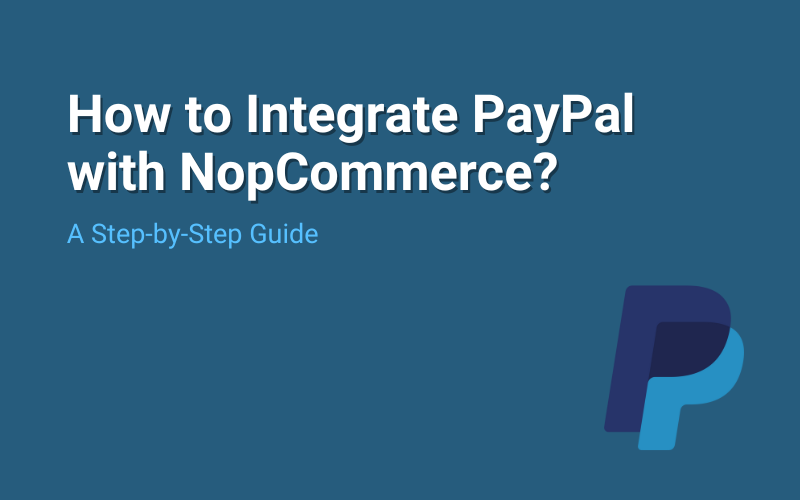NopCommerce, a popular open-source e-commerce platform, offers numerous payment gateway integrations, including PayPal. PayPal stands out as one of the most popular and trusted payment solutions globally, offering convenience and reliability to both merchants and customers. NopCommerce, an open-source e-commerce platform, empowers businesses to create robust online stores with various payment gateway integrations, including PayPal.
This comprehensive guide aims to walk you through the step-by-step process of integrating PayPal with NopCommerce. From setting up a PayPal Business account to configuring the integration within your NopCommerce store, we’ll cover everything you need to know to enable PayPal payments smoothly.
1. Creating a PayPal Business Account:
Before diving into the integration process, you’ll need to have a PayPal Business account. If you haven’t already created one, follow these steps:
1.1. Visit the PayPal website and click on the “Sign Up” button.
1.2. Select “Business Account” and provide the necessary information, including your business type, contact details, and business address.
1.3. Verify your email address and link a bank account or credit/debit card to your PayPal account for payment processing.
1.4. Once your account is verified and set up, you’re ready to move on to the next step.
2. Obtaining PayPal API Credentials:
To integrate PayPal with NopCommerce, you’ll need to obtain API credentials from your PayPal Business account. Here’s how:
2.1. Log in to your PayPal Business account and navigate to the Developer section.
2.2. Click on “Create App” to generate API credentials for your NopCommerce store.
2.3. Provide a name for your app, select the appropriate permissions, and create the app.
2.4. Once the app is created, you’ll receive the API credentials, including the Client ID and Secret Key. Keep these credentials handy as you’ll need them during the integration process.
3. Installing the PayPal Plugin in NopCommerce:
Now that you have your PayPal API credentials, it’s time to install the PayPal plugin in your NopCommerce store. Follow these steps:
3.1. Log in to your NopCommerce admin panel.
3.2. Navigate to the Plugins section and search for the PayPal plugin.
3.3. Install the PayPal plugin and activate it.
3.4. Once installed, navigate to the plugin settings and enter your PayPal API credentials (Client ID and Secret Key).
3.5. Select the appropriate PayPal environment (Sandbox for testing or Live for production).
4. Configuring PayPal Settings in NopCommerce:
After installing the PayPal plugin, you’ll need to configure the settings within your NopCommerce store. Here’s how:
4.1. Navigate to the Payment Methods section in your NopCommerce admin panel.
4.2. Select PayPal as a payment option and configure the settings accordingly.
4.3. Customize the payment method name, additional fees (if applicable), and order status.
4.4. Save the changes and proceed to the next step.
5. Testing PayPal Integration:
Before making PayPal live on your NopCommerce store, it’s essential to test the integration in a sandbox environment. Follow these steps to conduct a test transaction:
5.1. Create a test order on your NopCommerce store and proceed to the checkout.
5.2. Select PayPal as the payment method and complete the transaction using sandbox credentials.
5.3. Verify that the order is processed successfully and payment is received in your PayPal sandbox account.
5.4. Confirm that the order status is updated accordingly in your NopCommerce admin panel.
5.5. Repeat the testing process with different scenarios to ensure comprehensive functionality.
6. Making PayPal Live:
Once you’ve thoroughly tested the PayPal integration and ensured that everything is functioning correctly, it’s time to make PayPal live on your NopCommerce store. Follow these steps:
6.1. Switch the PayPal plugin settings to the Live environment by entering your live PayPal API credentials.
6.2. Update any relevant information or settings to reflect the transition from sandbox to live mode.
6.3. Test a live transaction to confirm that payments are processed correctly in the production environment.
6.4. Monitor the payment transactions and order processing in real-time to ensure a seamless transition.
Conclusion:
Integrating PayPal with NopCommerce offers a multitude of benefits, including secure payment processing, global accessibility, and enhanced customer trust. By following this comprehensive guide, you can seamlessly integrate PayPal into your NopCommerce store and provide your customers with a smooth and convenient checkout experience.
Remember to periodically review and update your PayPal integration settings to ensure compliance with PayPal’s policies and regulations. With PayPal enabled, you’ll be well-equipped to accept payments from customers worldwide, driving the success of your online business.


